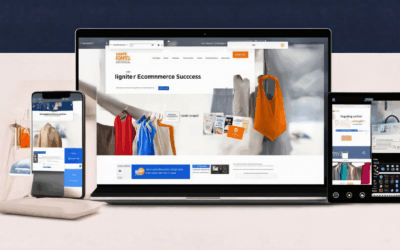In today’s competitive digital landscape, the effectiveness of your website design can mean the difference between driving meaningful engagement or falling short of your goals. A high-converting website is not just a design trend; it’s a strategic tool that aligns with your business objectives, ensuring visitors take action—whether that’s making a purchase, signing up for a newsletter, or exploring further. Understanding the principles behind high-converting designs is essential for businesses aiming to maximize their online potential. From crafting clear value propositions to optimizing user experience, every element of your website plays a pivotal role in boosting conversion rates. This guide delves into proven strategies, design best practices, and actionable insights to help you build a website that consistently delivers results.
Key Takeaways
- Enhance Call-to-Action (CTA) Performance: Make CTAs stand out with contrasting colors, clear labels, and personalize them to address visitors by name or offer tailored promotions.
- Improve Landing Page Design: Simplify layouts, streamline sign-up or checkout processes, and ensure a seamless user experience.
- Prioritize Mobile Optimization: Optimize for mobile responsiveness and fast loading speeds, possibly using AMP to enhance performance.
- Leverage Content Marketing Strategically: Create engaging content like blog posts, videos, and case studies, and share success stories and testimonials to build trust.
- Boost SEO Performance: Use relevant keywords, meta descriptions, and focus on technical aspects like fast loading times and mobile-friendliness.
- Utilize Social Proof Effectively: Display customer reviews and encourage user-generated content via social media to enhance credibility.
- Implement Retargeting Ads: Re-engage visitors who didn’t convert initially with dynamic ads based on their behavior.
- Leverage Email Marketing: Send segmented, personalized emails with exclusive offers and include clear CTAs to drive conversions.
- Conduct Continuous A/B Testing: Test various elements like headlines, images, and payment options to find optimal configurations.
- Focus on Security: Use SSL certificates and secure checkout processes to build trust and reduce conversion friction.
- Understand Industry Benchmarks: Recognize that conversion rates vary by industry, and aim to improve based on specific standards like those for e-commerce, SaaS platforms, and B2B services.
- Enhance User Experience: Ensure smooth navigation, fast loading times, and a mobile-friendly design to keep users engaged.
- Adopt Data-Driven Design: Use analytics tools to track user behavior and continuously optimize your website’s design and functionality.

What is a High Conversion Website?
A high conversion website is a platform designed to maximize the number of visitors who take a specific action, such as making a purchase, signing up for a service, or completing a form. This type of website focuses on driving user engagement and encouraging visitors to fulfill the primary goal of the site.
Key Characteristics of a High Conversion Website
- Clear Value Proposition : The website clearly communicates its benefits and why users should take action. This helps visitors quickly understand the value offered.
- Trust-Building Elements : Features like security badges, SSL certificates, and customer testimonials build trust, which is essential for conversions.
- User-Centric Design : The design is intuitive, easy to navigate, and optimized for mobile devices, ensuring a seamless user experience.
- Compelling Call-to-Action (CTA) : CTAs are prominent, clear, and action-oriented, guiding users toward the desired outcome.
- A/B Testing : Regular testing of CTAs, landing pages, and user journeys to optimize for maximum conversions.
- Personalization : Tailoring content and user experience based on demographics, behavior, or preferences to increase relevance.
- Mobile Optimization : Ensures the website performs well on all devices, as mobile usage continues to rise.
- Fast Loading Times : Quick load speeds improve user experience and reduce bounce rates.
- Error-Free Experience : A bug-free site ensures users can easily find what they’re looking for and complete their actions without issues.
- Analytics and Tracking : Tools like Google Analytics help monitor user behavior and measure success, allowing for continuous improvement.
By focusing on these elements, a high conversion website can effectively engage and convert its audience, achieving its stated goals.
How to Design a Website That Converts
To design a website that effectively converts visitors into customers, consider the following key strategies:
- Clarity and Structure:** Ensure your website has a clean layout with a clear hierarchy. Use intuitive navigation menus and a logical flow to guide users toward your goals, whether it’s making a purchase, signing up for a newsletter, or contacting your business.
- Compelling Content:** Create content that speaks directly to your target audience’s needs and desires. Use high-quality images, videos, and infographics to capture attention while maintaining readability. Incorporate clear calls-to-action (CTAs) such as “Shop Now,” “Sign Up,” or “Contact Us.”
- User Experience (UX):** Optimize for mobile responsiveness to ensure your site performs well on all devices. Streamline loading times, reduce clutter, and ensure smooth scrolling to enhance the overall experience.
- Conversion Rate Optimization (CRO):** Implement CRO techniques such as A/B testing different layouts and CTAs, lead capture forms, and pop-ups or tooltips to guide users toward completing actions like purchases or sign-ups.
- Search Engine Optimization (SEO):** Use meta descriptions, alt text for images, and structured data to improve your site’s visibility in search engines. Create content tailored to answer specific questions your audience might have, addressing each stage of the buyer journey.
- Social Proof:** Include customer reviews, ratings, and testimonials to build trust and credibility. Highlight popular products or services to encourage social sharing and word-of-mouth referrals.
- Analytics and Testing:** Continuously monitor your website’s performance using tools like Google Analytics. Track user behavior, conversion rates, and drop-off points to identify areas for improvement and optimization.
By combining these elements, you can create a website that not only attracts visitors but also drives meaningful interactions and conversions.

How to Design a High-Converting Landing Page
A well-designed landing page can significantly boost your conversion rates, driving more visitors to take action whether it’s signing up, downloading a resource, or making a purchase. Here’s a step-by-step guide to crafting a high-converting landing page:
- Start with a Strong Headline
- Include a Clear Value Proposition
- Add Visuals Strategically
- Create Scarcity or Urgency
- Optimize for Mobile
- Incorporate Trust Signals
- Use a Clean and Simple Design
- Optimize for Fast Loading Times
- Include Multiple CTAs
- Test and Optimize Continuously
Your headline should immediately grab attention and communicate the value proposition. Use action verbs and make it specific to your audience.
Within the first few sentences, clearly state why visitors should care and what benefit they’ll receive. Keep it concise and impactful.
High-quality images, icons, or videos can enhance visual appeal and reinforce your message. Use visuals that align with your brand identity.
Use limited-time offers, countdown timers, or highlighted features to encourage immediate action. This creates a sense of urgency.
More than half of users access websites via mobile devices. Ensure your landing page is responsive and fast-loading.
Display trust indicators like security badges, customer testimonials, or certifications to build credibility and reassure visitors.
A cluttered design can confuse visitors. Stick to minimalistic layouts with easy navigation and a logical flow.
Slow-loading pages can increase bounce rates. Compress images, leverage browser caching, and minimize JavaScript.
Place primary CTAs (like “Get Started” or “Sign Up”) in prominent positions, such as above the fold or near the bottom of the page.
Run A/B tests to identify what resonates best with your audience. Track metrics like click-through rates and conversion rates to refine your strategy.
By focusing on these key elements, you can create a landing page that not only attracts visitors but also drives meaningful actions and conversions.

How to Increase Website Conversion Rate
To boost your website’s conversion rate, consider implementing the following strategies:
- Optimize Call-to-Action (CTA) :
- Ensure CTAs stand out with contrasting colors and clear labels.
- Use A/B testing to identify high-performing CTAs.
- Personalize CTAs by addressing visitors by name or offering tailored promotions.
- Improve Landing Pages :
- Simplify designs to minimize clutter and enhance navigation.
- Streamline sign-up or checkout processes for a seamless user experience.
- Mobile Optimization :
- Optimize for mobile responsiveness and fast loading speeds.
- Consider implementing AMP (Accelerated Mobile Pages) to enhance mobile performance.
- Leverage Content Marketing :
- Create valuable content such as blog posts, videos, and case studies to engage visitors.
- Share success stories and testimonials to build credibility and trust.
- Enhance SEO Performance :
- Use relevant keywords and meta descriptions to improve search engine visibility.
- Focus on technical SEO by ensuring fast loading times and mobile-friendliness.
- Utilize Social Proof :
- Display customer reviews and case studies to reassure potential customers.
- Encourage user-generated content through social media sharing.
- Implement Retargeting Ads :
- Show retargeting ads to visitors who didn’t convert initially, using dynamic ads based on their behavior.
- Leverage Email Marketing :
- Send segmented, personalized emails with exclusive offers or discounts.
- Include clear CTAs within email content to drive conversions.
- Conduct A/B Testing :
- Continuously test various elements like headlines, images, and payment options to find optimal configurations.
- Focus on Security :
- Use SSL certificates and secure checkout processes to build trust and reduce conversion friction.
By strategically combining these tactics, you can enhance your website’s conversion rate and achieve your business goals.
What is Considered a Good Conversion Rate on a Website?
Conversion rates vary significantly depending on the industry, business model, and target audience. Here are some general guidelines:
- E-commerce Websites :
- 2%-12% (Higher for niches like fashion or luxury goods, lower for essential goods.)
- SaaS Platforms :
- 10%-30% (Due to recurring revenue models and problem-solving solutions.)
- Lead Generation Sites :
- 20%-40% (Focused on capturing contact information.)
- B2B Services :
- 25%-50% (Targeted marketing and high-value offerings.)
- News/Media Websites :
- 1%-3% (Focus on audience retention and engagement.)
- Local Businesses :
- 1%-5% (Dependent on offline visibility and local SEO.)
Key Factors Influencing Conversion Rates :
– User Experience : Smooth navigation and fast loading times.
– Mobile Optimization : Essential for reaching a broad audience.
– Personalization : Tailored content and recommendations.
– SEO Performance : Higher rankings drive more organic traffic.
– Trust and Security : Features like HTTPS and secure checkout processes.
– Retargeting Ads : Re-engage visitors who didn’t convert initially.
There is no universal “good” conversion rate, but understanding industry benchmarks and optimizing user experience can help achieve better results.

How Website Design Affects Conversion Rates?
Website design plays a pivotal role in determining the effectiveness of a website in driving conversions. From user experience to visual appeal, every aspect of design impacts how visitors interact with the site.
- Page Speed: Slow-loading websites can significantly reduce patience, leading to higher bounce rates. Optimize images, leverage browser caching, and minimize code bloat to ensure quick load times.
- Mobile Optimization: With over half of internet traffic coming from mobile devices, ensuring your site is responsive and touch-friendly is crucial. Mobile-first indexing by Google further emphasizes this necessity.
- Clear Call-to-Action (CTA): Visitors must understand the next step they should take. Use prominent buttons, concise language, and remove distractions to guide users toward conversions.
- Visual Appeal and Consistency: High-quality images and videos can capture attention, while inconsistent branding can confuse users. Maintain a cohesive look and feel across all pages.
- Ease of Navigation: A confusing navigation menu can lead users astray. Simplify navigation with intuitive menus and logical placement of important links.
- A/B Testing and Personalization: Continuously test different designs to identify what resonates most with your audience. Use analytics tools like Google Analytics or Crazy Egg to track behavior and optimize accordingly.
Incorporate these principles into your website design to maximize conversion rates. Always test and iterate based on data to stay ahead of competitors like 119WebDesign.com, ensuring your site remains both functional and visually appealing.
Learn more about optimizing your website design




0 Comments